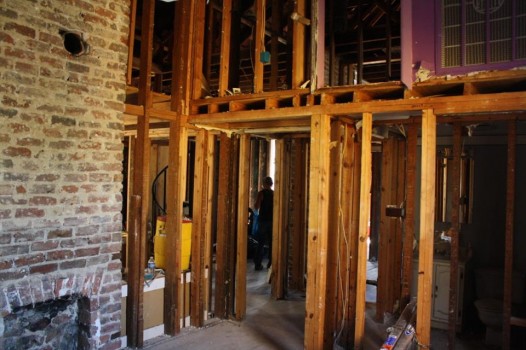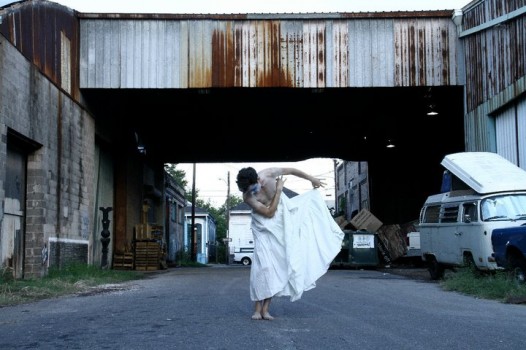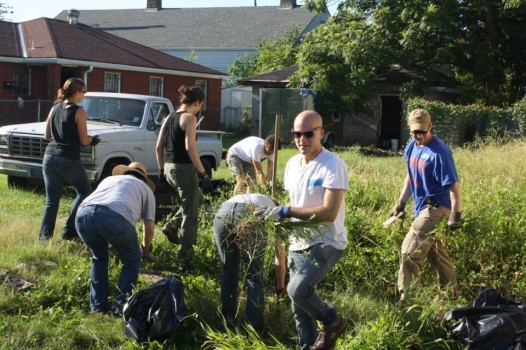One city may deem empty space luxury, another blight. Bearing a significant portion of New Orleans’ unutilized land, the vast and originally unbounded ninth ward hangs between potential and handicap. More than by large public works projects, this balance is tipped by houses, their fates, backyards and living rooms. One of these houses is 1239 Congress Street.

The large house in the Ninth Ward will host “The Sound Cooperative” music studio and community art happenings. (photo 1239)
I recently spoke to Mathew Sheard about his work at the cooperative, and prospects are sanguine. Approximately four months ago, Sheard, a veteran of New Orleans non-profit reconstruction, allied with four like-minded colleagues to launch their own project. The result, unfolding with remarkable celerity, is 1239. The house is currently gutted, and stands in all of its skeletal glory, the central brick chimney and heavy rafters show their resilience as much as their age.
Indeed, the house, a double shotgun, was constructed in the 1930’s, but is set apart from that archetype by renovations undergone in the 1980’s including a spiral staircase and a dividing wall between the front and the back of the house. The presence of this boundary allows 1239’s current designers to tear down the original dividing wall between the two shotguns in the front part of the house, providing around 450 square feet of space – a main deck, a desegmentation and resegmentation of unutilizable space into utilizable space. Sheard proffered the room as a community space, a place to bring people together, devoted to the arts. Though “everything is on the table,” the front room seems intended to a place for music to happen. It will not be a venue, but, as I understood it, rather a living room for neighborhood artists and audience.
The two rooms behind this, the erstwhile kids room and master bedroom, will be
put to use as a soundproof recording studio and a storage space, respectively. The one is more challenging than the other, and 1239, or “The Sound Cooperative,” currently has a kickstarter out for the purchase of soundproofing materials and studio equipment. The room will provide local musicians with recording capabilities, and in return, the musicians will be asked to provide music lessons to local kids, quid pro quo, minimizing the (troublesome) role of finances in community service.
Indeed, the 1239 crew hopes the house to be financially independent. The back
section of the house, planned as an efficiency unit in the 1980’s remodeling, will be restored, and rented out to cover the bills from the front part of the house. Without walls, the fluidity and interdependence of the three parts of the house could be very easily abstracted; maintaining that tripod sense once the walls are built could be challenging.

Skin-Horse performed ‘Port/Architect’ in Architect’s Alley, Marigny during the 2010 New Orleans Fringe Festival (photo Zac Manuel)
In the mean-time, water and electricity will (at least) be ready for Fringe Festival
this November, when 1239 will host Skin-Horse theater. Skin-Horse has been operating in New Orleans for two years, and during that time they have performed both traditional and non-traditional plays. Their work is generally site-specific. Last Fringe Festival, they put on a piece in a warehouse, and this year they aim to do the complete opposite, performing a play in a living room.
If staging a play in a warehouse was a “physical aesthetic exploration,” Skin-
Horse hopes staging a play at 1239 will be “a psychological exploration.” This calls for not only an increased resolution, but also for a qualitatively different audience role. I spoke to two of the Skin-Horse folks, and they were very excited about the prospect of a small, intimate audience, an audience that would very much share in the claustrophobia and paranoia of the characters being played.
The play, Sarah, has been created around the space of 1239. The living room is
to engender a sense of voyeurism in the audience, a sensation of being trapped
eavesdroppers, of looking not upon a situation but of being inside of it. This audience will be small, no more than 20 people, and Skin-Horse will use this proximity to engage a near “cinematic” level of detail on the part of its audience, down to the batting of an eyelash or the flick of a hand.

Members of Skin-Horse theater assist with cleanup at 1239 Congress, trading labor for theater (photo 1239)
The living room is to be coeval with Sarah. This partnership has less to do with
some new artistic version of vertical integration and more with the old trade of labor for rent between Skin-Horse and 1239. Skin-Horse has had the opportunity to participate in the construction of their venue, a rare thrill (and travail) for theatre troupes. Talking about this year’s performance, I received the impression that Skin-Horse was very interested in detail and control. The room and the play are forming jig-sawed together, the audience will be put into a very specific psychological environment, and they will be given access to a subtlety of motion and intimation that is generally unavailable to larger performances. Brittleness is an impressive texture of art, but carries concomitant risks, and the performance of Sarah will be an interesting experiment in space and design, the first of many for 1239 Congress.
 NOLAbeings Multimedia artist Claire Bangser created NOLAbeings as a portrait-based story project that marries...
NOLAbeings Multimedia artist Claire Bangser created NOLAbeings as a portrait-based story project that marries...  Voodoo in New Orleans: Reviving history: New Orleans fortune telling This article takes a deep dive into the history of Voodoo in New Orleans, its hybridization with Catholicism, and its present-day place in the city's culture. The author visits fortune-tellers in the French Quarter, using their guidance as a tool for introspection rather than a deterministic predictor of the future. Through her experiences in New Orleans, the author feels a mystical connection to both the past and the future.
Voodoo in New Orleans: Reviving history: New Orleans fortune telling This article takes a deep dive into the history of Voodoo in New Orleans, its hybridization with Catholicism, and its present-day place in the city's culture. The author visits fortune-tellers in the French Quarter, using their guidance as a tool for introspection rather than a deterministic predictor of the future. Through her experiences in New Orleans, the author feels a mystical connection to both the past and the future. 